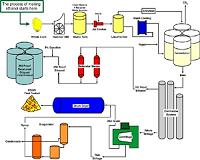 |
Oak Ridge TN (SPX) Feb 17, 2011 Bioethanol from new lines of native perennial prairie grass could become less costly because of plant engineering by The Samuel Roberts Noble Foundation and fermentation research at Oak Ridge National Laboratory. In a paper published in the Proceedings of the National Academy of Sciences, researchers describe their transgenic version of switchgrass as one that produces about one-third more ethanol by fermentation than conventional switchgrass. This improved plant feedstock will be able to generate more biofuel per acre, benefiting not only the transportation sector but also the growers and farming community. "Recalcitrance, or a plant's natural defenses against insects, fungus and the weather, is widely acknowledged as being the single biggest barrier to the production of biofuel and biochemicals from switchgrass and other lignocellulosic materials," said Jonathan Mielenz, a co-author and member of the Department of Energy lab's BioEnergy Science Center. For years researchers have sought better ways to break down the plant's defense system, and while substantial progress has been reported, recalcitrance remains a significant challenge. Despite this obstacle, switchgrass holds great promise as a bioenergy feedstock because it is a native perennial plant, grows with high yields and requires little nitrogen and water. These characteristics made it an attractive target for transgenic improvements. To achieve their goal, a team led by Zeng Yu Wang of The Samuel Roberts Noble Foundation in Ardmore, Okla., chose to "downregulate" - a process that involves decreasing a cellular component - the caffeic acid 3-O-methyltransferase, or COMT, gene - in the Alamo variety of switchgrass. This change decreased the plant's structural "glue," lignin, by about one-eighth. The scientists chose this gene based on encouraging results of lignin modification from previous Noble research conducted in alfalfa and other plant species. What the team from the Noble Foundation ended up with, as discovered by a team led by Mielenz, is a switchgrass that is more easily converted to biofuels under milder conditions and with much lower costly additions during fermentation. "The presence of lignin in plant cell walls interferes with the fermentation to produce biofuels," said Wang, who noted that enzymes are the single largest processing cost component for bioconversion of biomass after the biomass itself. "The transgenic lines require lower temperature preprocessing and only one-quarter to one-third the level of enzymes for equivalent ethanol fermentation compared to the unmodified switchgrass. This significantly lowers the cost of biofuels and biochemicals from this switchgrass." The paper, titled "Genetic manipulation of lignin reduces recalcitrance and improves ethanol production from switchgrass," will be published online this week. Other authors are Chunxiang Fu, Xirong Xiao, Yaxin Ge, Fang Chen, Joseph Bouton, and Richard Dixon of The Samuel Roberts Noble Foundation, Choo Hamilton and Miguel Rodriguez of ORNL, and Marc Foston and Art Ragauskas of Georgia Institute of Technology.
Share This Article With Planet Earth
Related Links Oak Ridge National Laboratory Bio Fuel Technology and Application News
 Celanese Signs LoI For Ethanol Production Facilities In China
Celanese Signs LoI For Ethanol Production Facilities In ChinaZhuhai, China (SPX) Jan 21, 2011 Celanese has announced that its wholly owned subsidiary, Celanese Far East Limited, has signed letters of intent to construct and operate industrial ethanol production facilities in Nanjing, China, at the Nanjing Chemical Industrial Park and in Zhuhai, China, at the Gaolan Port Economic Zone. Pending project approvals, Celanese could begin industrial ethanol production within the next 30 m ... read more |
|
| The content herein, unless otherwise known to be public domain, are Copyright 1995-2010 - SpaceDaily. AFP and UPI Wire Stories are copyright Agence France-Presse and United Press International. ESA Portal Reports are copyright European Space Agency. All NASA sourced material is public domain. Additional copyrights may apply in whole or part to other bona fide parties. Advertising does not imply endorsement,agreement or approval of any opinions, statements or information provided by SpaceDaily on any Web page published or hosted by SpaceDaily. Privacy Statement |